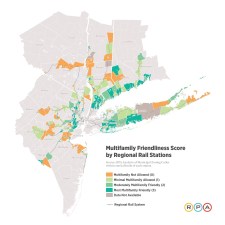HUD Grant Will Lay the Groundwork for TOD in New York and Connecticut
From Suffolk County to New Haven, the communities of New York and Connecticut are planting the seeds for a serious investment in transit-oriented development in the years ahead. Funded by a $3.5 million grant from HUD’s Sustainable Communities program, nine cities, two counties and six regional planning organizations have come together to develop regional plans for tying sustainable transportation and new development. Those plans are the first steps toward an impressive array of projects across the region, from new rail stations to new zoning codes around existing transit hubs.
The New York and Connecticut region have the best transit and rail network in the country, explained Robert Yaro of the Regional Plan Association, which is administering the collaboration, but also the largest income gaps and most expensive housing. For the region to continue to prosper in the 21st century, he said, it needs to embrace its transportation system as the backbone for continued development, including affordable housing.
By mid-century, said Adolfo Carrion, the regional HUD administrator and former director of the White House Office of Urban Affairs, the country will need an additional 200 billion square feet of development to house its growing population and economy. “It has to be vertical,” said Carrion. “It has to be reliant on mass transit.”
For that to happen, local government needs to lay the groundwork now, so that when the economy recovers from recession and the real estate market again kicks into high gear, dense and transit-oriented projects are built. This grant makes that kind of planning possible.
In New York City, for example, the Department of City Planning will develop strategies to encourage transit-oriented development at Metro-North stations in the Bronx and at the East New York LIRR station. “Growth in New York City in the right places actually takes cars off the road,” said Planning Commissioner Amanda Burden. The Bronx was selected due to its strong growth in recent years, she added. “The logical place for the Bronx to grow more is along its Metro-North corridors.”
In East New York, fantastic transportation resources are paired with major economic challenges and strong community organizations to partner with. The area near the train station will become what Burden called “a really complete neighborhood, live/work, mixed-income, mixed-use, that’s really walkable, bikeable with strong mass transit.”
In Stamford and Bridgeport, the grant will fund feasibility studies for new rail stations, which could catalyze the redevelopment of entire new neighborhoods.
Nassau County will develop plans for infill development at three Long Island Railroad stations, which County Executive Ed Mangano called “a new model of suburban growth that both protects existing communities and open space while generating job opportunities, workforce housing, and property tax revenue.” Suffolk County will work to expand its much-lauded transfer of development right program, which is currently used to protect the Long Island pine barrens.
The other projects funded by the partnership, all of which look impressive, can be found at its new website.
Politically, the partnership is also notable for who isn’t involved. First, the federal government cut out state government from the funding process, turning instead to a non-profit to facilitate cooperation across state lines.
“It’s hard for states to give up control,” said New York State Department of Transportation Commissioner Joan McDonald, who also supported this project while in the Connecticut state government. Working directly with cities and counties, however, is a “gamechanger,” said Carrion, empowering the local governments that are the “natural partners” in efforts to build livable communities.
Also absent was one-third of what is normally considered a tri-state region: New Jersey. “We hoped that this would be the Newark to New Haven corridor,” revealed Bridgeport Mayor Bill Finch, “but then one of the states dropped out.” New Jersey ultimately applied for a Sustainable Communities grant on its own, said Yaro, who wryly noted that New Jersey’s application was not a winner.
